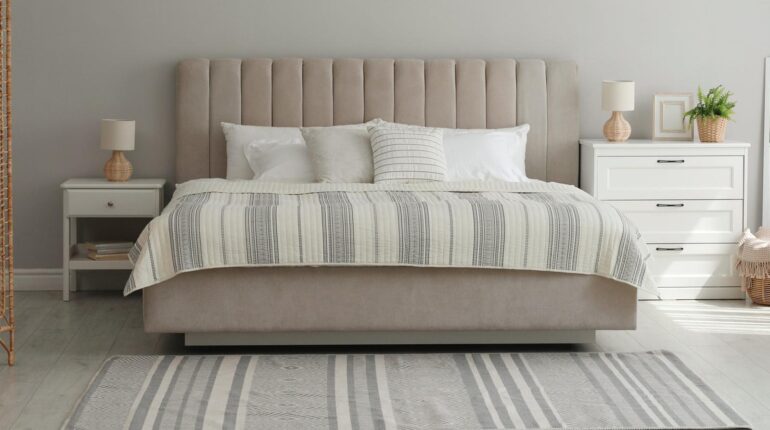📌 The Secret Rule Interior Designers Use to Size Bedroom Rugs (Most People Get This Wrong)

Posted 1 August 2025 by: Admin
Image d’illustration © TopTenPlay EN
The Essential Role Of Rugs In Bedroom Design
Beyond their obvious decorative appeal, rugs serve multiple crucial purposes that transform bedroom functionality and aesthetics. The morning ritual of stepping onto a soft and cozy surface instead of cold hardwood or tile creates an immediate comfort upgrade that impacts your daily routine.
Yet comfort represents just the beginning. A strategically placed rug helps your room feel cohesive, acting as a visual anchor that ties together disparate furniture pieces and color schemes. This anchoring effect creates spatial definition, particularly important in open floor plans or larger bedrooms where furniture can appear to float without clear boundaries.
Even homeowners blessed with stunning hardwood floors or premium flooring often hesitate to introduce rugs, fearing they’ll diminish their investment. This concern misses a fundamental design principle: rugs enhance rather than hide beautiful flooring. The contrast between exposed flooring at the room’s perimeter and the textured warmth of a well-chosen rug creates visual depth and layering that sophisticated interiors demand.
The bedroom rug functions as one of the simplest yet most impactful decorating tools available. It introduces pattern, color, and texture without permanent commitment or major renovation. Whether your space features pristine marble, reclaimed oak, or basic carpeting, the right rug elevates the entire room’s design quotient while delivering tangible daily benefits.
Understanding these multifaceted advantages explains why rug selection deserves careful consideration rather than rushed decisions based solely on visual appeal.
Image d’illustration © TopTenPlay EN
Standard Size Guidelines For Twin And Full Beds
This careful selection process begins with understanding precise measurements that separate amateur decorating from professional results. For full beds, interior designers consistently recommend rugs measuring 5 by 8 feet or 6 by 9 feet as the optimal starting point. These dimensions provide the foundation for proper spatial relationships between bed and floor coverage.
However, standard measurements require adjustment based on your specific bed frame characteristics. Bulky bed frames with substantial footboards, ornate carved details, or platform bases demand size increases of one to two inches in each direction. This seemingly minor adjustment prevents the visual compression that occurs when rugs appear undersized relative to substantial furniture pieces.
The industry’s golden rule establishes 24 inches of rug extension on all sides of your bed as the ideal proportion. This measurement creates visual balance while ensuring practical functionality when stepping out of bed. Rugs pressed directly against walls eliminate this crucial breathing room and immediately signal amateur placement.
Extra-long twin beds present unique challenges that standard sizing charts overlook. A 6-by-9-foot rug can accommodate these extended frames, but positioning becomes critical to maintain proper proportions and avoid awkward gaps or overhang.
Yet experienced designers understand a fundamental truth: « The size of your bed represents just the starting point, not the final answer. » Room dimensions, furniture placement, and traffic patterns ultimately determine whether these standard guidelines work or require significant modification for your specific space.
Image d’illustration © TopTenPlay EN
Room Layout And Spacing Constraints
These spatial realities transform theoretical measurements into practical limitations that demand strategic adaptation. Professional designers follow the two-foot rule: maintaining approximately 24 inches of open floor space between your bed and walls on three sides creates visual breathing room while preserving essential walking paths.
This spacing requirement immediately reveals why simply selecting the largest possible rug often backfires. Oversized rugs that extend too close to room perimeters create cramped, visually compressed spaces that feel smaller than they actually measure. The fourth side—typically where your bed meets the wall—requires only a small gap between rug edge and baseboard trim to prevent awkward visual contact.
Room shape introduces additional complexity that standard sizing charts completely ignore. Narrow rectangular bedrooms demand different approaches than square layouts, while L-shaped spaces or rooms with architectural features like bay windows require custom solutions that prioritize traffic flow over symmetrical placement.
The fundamental challenge lies in balancing rug coverage with open floor space. While you want sufficient rug area to anchor your bed and provide comfortable foot placement, excessive coverage eliminates the clean floor lines that make rooms feel spacious and organized.
« You’re not decorating in a vacuum—you’re working within physical constraints that ultimately determine success or failure, » explains one interior design professional. Door swing clearances, closet accessibility, and natural walking patterns between furniture pieces create invisible boundaries that override any measurement formula, demanding practical compromise over design idealism.
Image d’illustration © TopTenPlay EN
Flexible Placement Options For Different Spaces
These practical compromises translate into three distinct rug placement strategies, each designed to maximize both comfort and functionality within your specific spatial constraints.
The large rug approach accommodates your bed plus all bed-related furniture—nightstands, benches, and even accent chairs—creating a unified carpet island that defines your entire sleeping zone. This comprehensive coverage works best in spacious bedrooms where you can maintain proper wall clearances while still achieving full furniture integration.
Medium-sized rugs offer the middle ground, sitting exclusively underneath your bed frame while leaving nightstands and other furniture on bare floor. This placement provides essential foot comfort without overwhelming smaller rooms or consuming excessive visual space.
For compact bedrooms, the small perpendicular rug positioned at your bed’s bottom third delivers targeted comfort exactly where you need it most. This strategic placement captures the area where you sit on your bed’s edge and step onto the floor, often extending under a bedroom bench if present.
Extremely tight spaces benefit from twin side rugs flanking your bed, providing soft landing spots for morning foot placement without central floor coverage. Alternatively, a narrow runner rug positioned solely at your bed’s foot creates a welcoming pathway while preserving maximum open floor area.
Runner rugs demand their own spacing rule: maintain at least three inches between rug edges and walls to prevent cramped visual contact. Most critically, factor in door swing clearance around your bedroom entrance—overlooking this detail creates the rug-size mistake that can completely ruin your room’s functionality, turning design enhancement into daily obstacle.




















